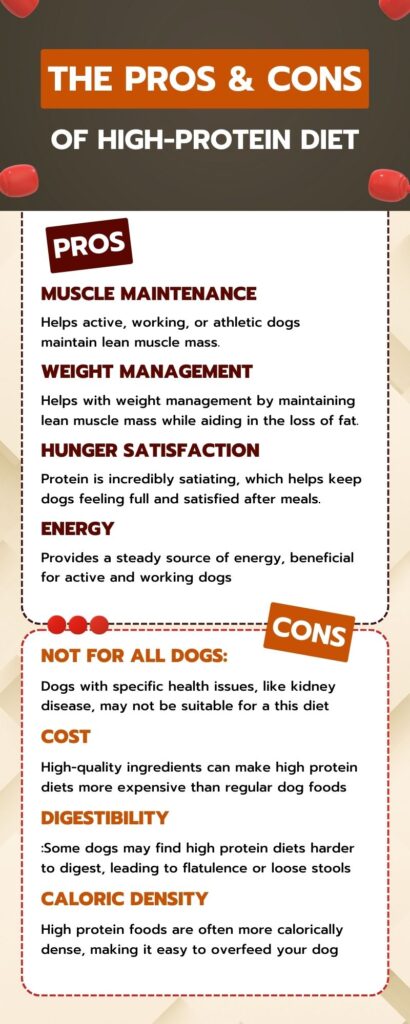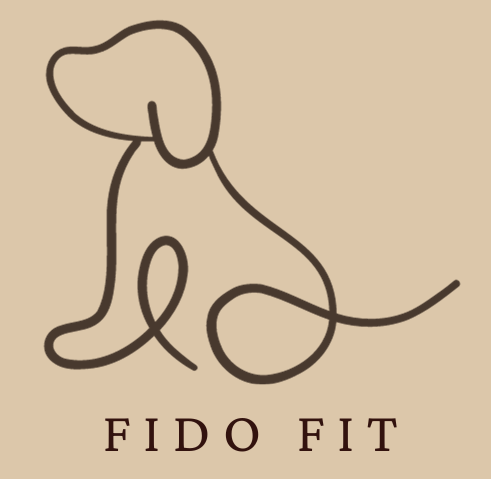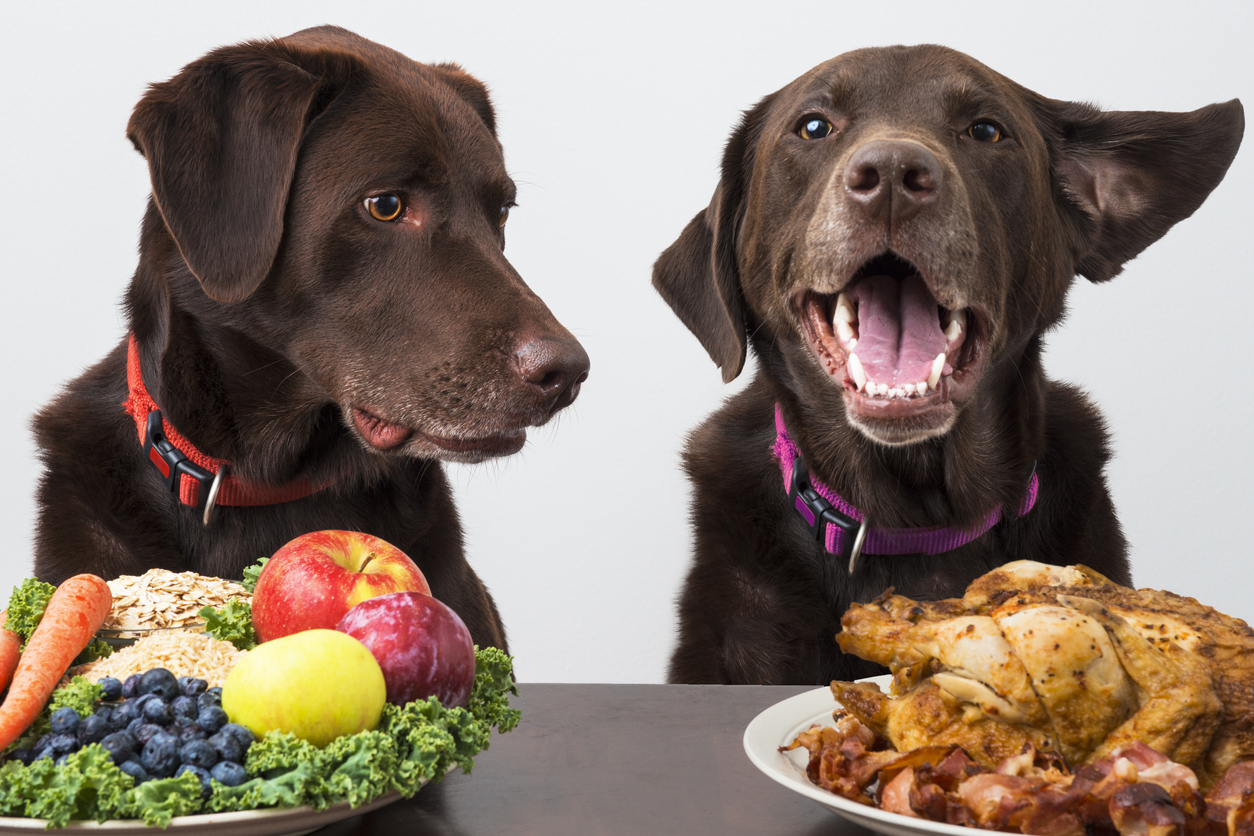Understanding dog’s nutritional needs is key for your pet’s complete and balanced diet. Protein is one of the most component’s of any dog’s diet and plays an important role in their growth, healthy skin, immune system, and overall health. It’s an important source of the essential amino acids, necessary for the synthesis of muscles, tissues, hormones, enzymes and antibodies.
But how much protein is enough for your furry friend? The answer to this question depends on your dog’s age, size, activity level and any existing health conditions. In this article we will provide you with some guidelines how to determine the right amount of protein for your dog.
How Much Protein Does my Dog Need?
According to the American Feed Control Officials (AAFCO) providing guidelines for pet food in North America, adult dogs (maintenance) need 18% minimum dry protein. Puppies (growth & reproduction) require a minimum of 22.5% dry protein content. Dry protein known also referred to as crude protein is a technical term used to assess a nutrient and can be found at the back of dog food bags.
Please keep in mind, these are the minimum recommendations, and most commercial dog foods contain more protein. Proteins are not made equal and each pet parent needs to consider the protein source quality. Meat, poultry, fish, and eggs are among the best-quality proteins providing a full amino acid profile that are more easily absorbed and digested by the dog’s body.
Factors that affect your dog’s protein needs
Now let’s have a closer look how different factors affect your dog’s needs depending on her life stage, size, breed, activity levels, and health conditions.
Age
Puppies who are still growing and developing rapidly, require more protein than adult dogs. Senior dogs may also benefit from a high protein diet to help maintain lean muscle mass and overall health irrespective of the dog’s life stage.
- growing puppy and pregnant or nursing female dog should eat 22.5%-25% crude protein
- adolescent dogs’s diet should include about 20% crude protein content
- adult dogs require about 18% of crude protein
- senior dogs need approximately 28% crude protein minimum
| Life Stage | Minimum Protein Requirement (Dry Matter Basis) |
| Puppy (Growth) & pregnant or nursing dog (Reproduction) | 22.5% – 25% |
| Adolescent dog | 20% |
| Adult dog (Maintenance) | 18% |
| Senior dog | 28% |
Breed & Size
Larger breeds such as Great Dane, Leon Berger, Cane Corso may require more protein to support larger muscles than smaller dogs. Depending on your dog’s size your vet can recommend a minimum of 22% for larger dogs.
Activity level
Active dogs such as Labrador Retrieviers, Huskies, Dalmatians, and Border Collies or working dogs have naturally higher energy needs and require more protein to maintain lean muscle mass.
Other Health Conditions
Dogs with certain health conditions, such as chronic kidney disease (CKD), may require a diet with a restricted protein content. It is essential to consult your veterinarian to determine the appropriate protein level for dogs with health conditions. At the same time, high protein diets are known to reduce seizure frequency in dogs and to have an anti-cancer properties.
When you shop for dog food, make sure you check the guaranteed analysis on the packaging. It will tell you how much crude protein (and other nutrients) this dog food contains. Remember that quantity does not equal quality which is why it’s important to look for minimally processed meats and ingredients you can easily understand.

Why protein in dog food is so important?
Protein, is the building block of life! When dogs eat protein, amino acids are released and absorbed for building and maintenance of muscle mass. No other nutrient can do it and that’s why protein plays such an important role in your dog’s diet. Amino acids are key for repairing tissues, producing hormones, and supporting a stable and healthy immune system of our furry friends.
Basically, it’s the stuff that keeps your dog healthy, happy, and strong.
Young dogs, in particular, need plenty of protein as they are growing and developing very quickly. For an adult dog, protein is necessary to maintain their muscles as well as keep their organs, skin, and coat in good shape.
Protein deficiencies can be harmful and potentially causing weight loss, reduced growth, weakened immune system.
High Quality Protein Sources for Dogs
Not all proteins are made equal. The easier for dogs to absorb and digest, the higher is the quality of protein.
High quality protein
The best dog food is with fresh meat and fish ingredients to ensure best flavour and digestibility. Chicken is the best high protein dog food source as it’s low in fat and high in amino acids. The best sources of high protein dog foods include:
- Poultry (chicken, turkey, duck, geese)
- Red meat (beef, lamb, pork)
- Fish (salmon, whitefish, tuna)
- Eggs
- Others (rabbit, venison, bison)
| Meat Type | Approximate Protein Content (Dry Matter Basis) |
| Chicken, Turkey | 70-80% |
| Beef, Lamb | 60-70% |
| Fish | 60-80% |
Lower quality protein
Plant based proteins are commonly included in dog food and are suitable for dogs that are sensitive or even allergic to protein. Unless it’s a medical necessity, it’s not recommended to keep your dog exclusively on a plant based protein diet which is considered as lower quality protein content as they don’t provide all the essential amino acids that your dog needs. Some examples of plant-based protein sources:
- Corn
- Soy
- Wheat
Plant-based proteins are commonly included in dog foods and are ideal for dogs with sensitivities and allergies to meat protein. Dogs are omnivores, so they can be vegetarian or vegan as long as their food meets their nutritional needs. However, your vet is unlikely to recommend a plant-based diet for your dog unless it’s medically necessary.
Many commercial dog foods use cereal grains as their main ingredient because they are a good source of energy, and support metabolism. Most common grains used in dry dog food include rice, corn, wheat, barley, and oats.
Other examples of dog food of lower protein quality are different byproducts:
- Corn Gluten : a byproduct of corn processing often used as a cheap protein filler in lower-quality dog foods
- Wheat Gluten: a byproduct of wheat processing which is very difficult to digest by dogs.
- Animal byproducts: parts of animals such as organs, bones, and offal. They are often used as a cheap protein source in low quality dog food
- Poultry byproducts: similar to meat by-products but made from poultry (may include heads, feet, viscera).
Remember, it’s always best to choose a dog food that lists a high-quality, identifiable animal protein source as the first ingredient. Consult your veterinarian or a certified pet nutritionist for the best advice on feeding your dog.
What are the benefits of Protein in Dog’s diet?
Protein is very important for dogs, just as it is for us and should be considered as key element of dog nutrition. Protein helps build and repair tissues, is key in hormone creation, and is the building block of all cells in dog’s body including bones and muscles.
Improves coat and skin health
Protein is key for coat health and muscle development since dog’s coat is made in of 95% protein. 20% to 30% of your dog’s protein intake is used to support their skin and coat health.
Supports muscle development and growth
Animal-based protein is rich in non-essential and essential amino acids such as isoleucine, valine, leucine, and lysine. Isoleucine helps muscle injuries heal and increases their endurance. Valine is especially important for muscle coordination, supports muscle growth and tissue repair.
Leucine and lysine are key for healthy adult dogs to build and maintain their muscles and bones.
Several amino acids in animal-based proteins, like histidine, play a significant role in immune function. Histidine metabolises into histamine, which helps a dog’s body to respond to allergens.
Gives energy boost
Dietary fats from high protein food are the most important source of energy for healthy dogs. It’s possible thanks to the protein breakdown process into essential and non essential amino acids. Some of them produce energy but not as efficiently as dietary fat. This is why we need to maintain a balance of healthy fats and protein to maintain the right energy levels.
Interestingly, dogs do not need carbs in their diet for energy which we have already described in this post on keto diet. While carbs aren’t bad for dogs (they can convert glucose into energy), dog’s food rich in carbs doesn’t provide the best nutritional value. This is why the American Feed Control Officials (AAFCO) guidelines don’t provide a minimum carbohydrate requirement for dog’s nutritional health.

Great for weight management
Protein is great for managing your dog’s weight and it’s especially when you are interested in your dog’s weight loss.
Firstly, a high-protein diet helps protect lean muscle mass during the weight loss process, which is crucial for maintaining metabolic rate. When dogs lose weight, it’s important that they lose fat and not muscle.
Secondly, high protein dog food is very satiating, meaning it helps your dog feel full and satisfied after eating which can help prevent overeating and weight gain
Lastly, protein metabolism (digesting) requires more energy than digesting fats or carbohydrates. It means a high-protein diet actually increases calorie burn throughout the day. This is often referred to as the ‘thermic effect of food‘.

High Protein Dog food: How Much protein is good for your Dog?
As a dietitian I often get asked about high protein dog diets. Let’s have a look what it means, what are the benefits and if there are any downsides.
There is no strict definition what we mean by a ‘high protein’ diet but it’s widely accepted that a high protein dog food typically contains more than 30% protein on a dry matter basis. It’s noticeably more than the AAFCO minimum recommendations of 22.5% protein intake for puppies and 18% for adult dogs.
High protein diets are often based on high-quality animal protein pet foods as main ingredient, such as poultry, lamb, or fish is a great way to keep your fido looking and feeling great.
Can dogs have too much protein?
While protein is a crucial part of dog’s diet, it’s important to make sure it’s balanced and includes all essential nutrients in the right amounts.
Generally, excess protein shouldn’t cause problems for healthy dogs. However, too much of a good thing can be bad for some dogs, especially with pre-existing health conditions such as kidney dysfunction or kidney disease.
The remaining protein which isn’t broken into amino acids is converted into energy, stored as fat or passed through the urine. Additional fat can lead to weight gain and excess protein can put unnecessary stress on the kidney function.
Protein restriction should be considered if your dog suffers from certain medical conditions such as liver and/or kidney disease.
High-protein diets can lead to dehydration if your dog isn’t drinking enough water, as more water is needed to metabolise protein.
Due to all the above it’s always best to consult with a veterinary medicine specialist to determine the right amount of protein for your dog. Balance is key!
What about dogs with food allergies?
In fact, protein is one of the most common causes of food allergies in dogs. Dog’s immune system who has a protein allergy mistakenly identifies protein as harmful and mobilises its immune response against it. The most common allergen in dogs include beef, chicken, eggs, and dairy, however dogs can be allergic to any type of protein. Itching, redness, and digestive problems are among the most typical protein allergy symptoms. If you suspect your dog has a food allergy, you will need to perform a food trials in consultation with your vet to determine which ingredients are causing the allergic reaction.
Protein supplements for dogs
Luckily most commercial dog food include the right amount of macro nutrients and most dogs can get enough protein from their regular diet. However, there are certain situations where using protein supplements may be beneficial.
- Puppies and Growing Dogs: Puppies and young dogs that are still growing may benefit from a protein supplement to help support their muscle and tissue development
- Active and Working Dogs: Dogs that are very active , or that participate in activities like hunting, or herding, may have higher protein needs
- Senior Dogs: A protein supplement can help support muscle maintenance in senior dogs
- Dogs with Certain Medical Conditions: Some medical conditions, like cancer or kidney disease, may affect a dog’s protein needs
- Dogs on a Home-cooked or Special Diet: If you’re preparing your dog’s food at home, or if your dog is on a special diet for medical reasons, it may be difficult to provide enough protein from regular food sources. A protein supplement can help ensure your dog is getting enough protein.
Putting it all together
Protein is among the most important components of a dog’s diet and plays a vital role in their growth, development, and healthy life. It’s key for building and maintaining muscles, repairing tissues, producing hormones, and supporting dog’s immune system.
Too much protein or too little protein can be harmful which is a balanced diet is key for your dog’s health.
The amount of protein a dog may vary and depends on different factors such as dog’s life stage, size, breed type, activity level and overall health. While AAFCO defines the minimum protein intake for dogs at 22.5% for puppies and 18% for adult dogs on a dry matter basis, many dogs may benefit from a higher protein diet.
The benefits of a high protein diet include muscle maintenance, weight management, and steady energy supply. However, high doses of dietary protein may not be suitable for all dogs, particularly those with specific health issues like kidney dysfunction. may not be suitable for all dogs, particularly those with specific health issues like kidney disease.
High-quality protein adult dog food can be found in red meat meat, poultry, fish, and eggs, while low-quality sources include corn gluten, soy, and several by-products. It is always recommendable to choose dog food with high-quality, animal protein sources listed as the first ingredient and consult a vet or certified veterinary nutritionist for personalised recommendations.
The good news is, commercial pet foods usually make it easy for pet parents to provide enough protein and other nutrients to their dog once they have established their dog’s dietary needs.

